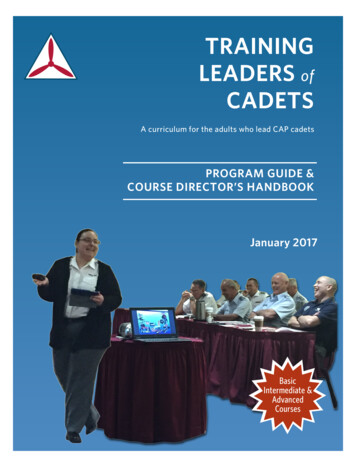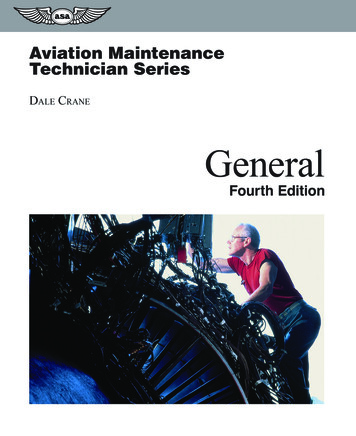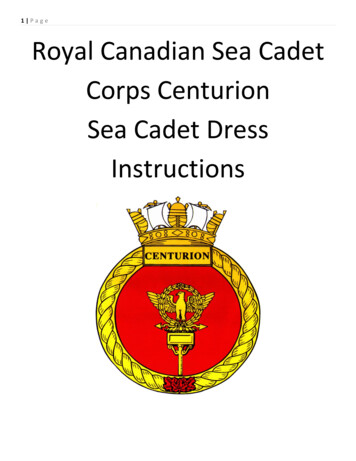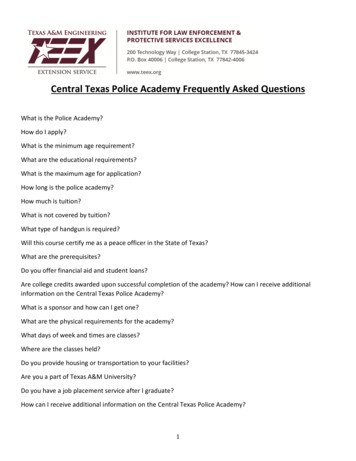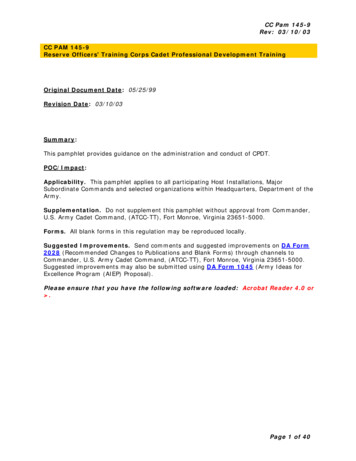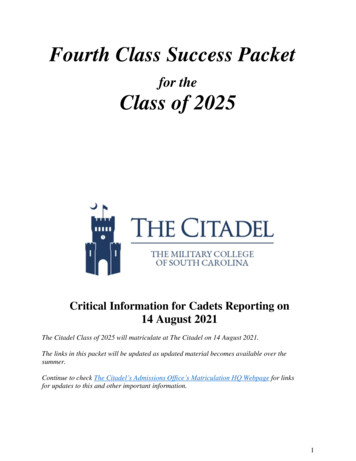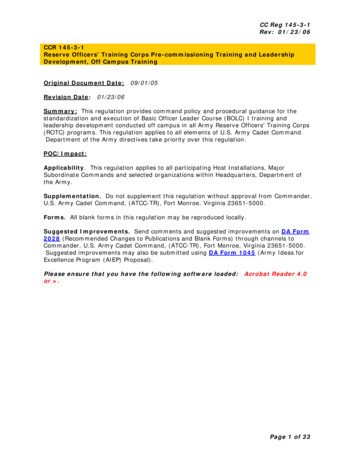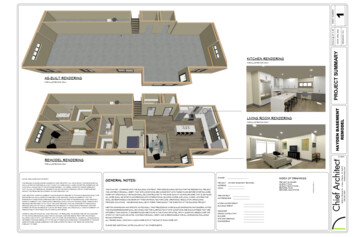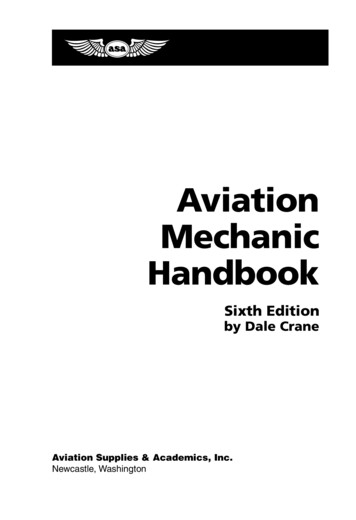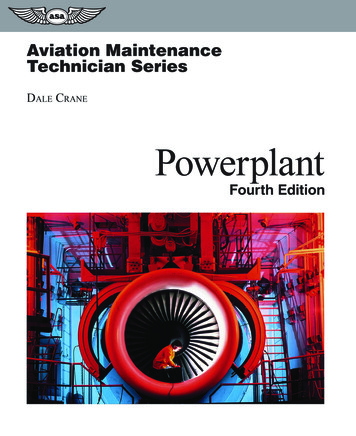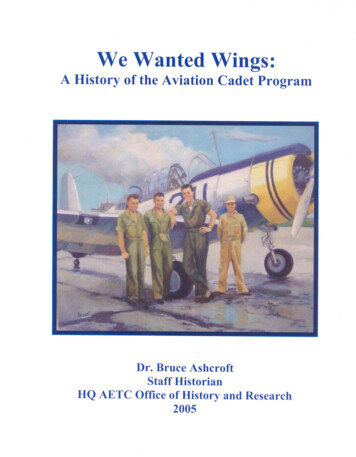
Transcription
Cover illustration: “Aviation Cadets in Training – 1943” by Dottie Knight.(Courtesy, United States Air Force Art Collection)
WE WANTED WINGS:A HISTORY OF THE AVIATION CADET PROGRAMDr. Bruce A. AshcroftStaff HistorianHQ AETC/HO2005
OFFICER CODEDuty well performed, Honor in all things, Country before self.AVIATION CADET HONOR CODEArticle 1: An Aviation Cadet will not knowingly make any false statement, written orverbal, while acting in any capacity, official or otherwise, or in any situation reflecting onthe Aviation Cadet Corps or the Air Force.Article 2: An Aviation Cadet will not take or receive the property of another person, orpersons, under any conditions, without specific authority of that person or persons.Article 3: An Aviation Cadet will not impart or receive any unauthorized assistance,either outside or inside the classroom or places of instruction, which would tend to giveany Aviation Cadet unfair advantage.Article 4: An Aviation Cadet will not quibble, use evasive statements, or technicalities inorder to shield guilt or defeat the ends of justice.Article 5: An Aviation Cadet will report any violation of honor by another AviationCadet of which he is witness or has unquestionable knowledge.Article 6: An Aviation Cadet will not commit any act of intentional dishonesty which willreflect in any way on the honor and integrity of the Aviation Cadet Corps and the AirForce.Officer Code and Cadet Honor Code both frombrochure, “Aviation Cadet Knowledge,”Preflight Training School, Lackland AFB TX,1959.ii
iii
iv
TABLE OF CONTENTSOfficer Code and Aviation Cadet Honor CodeForewordTable of ContentsList of FiguresIntroductionChapter I – The Flying Training Program through World War IThe Punitive ExpeditionWorld War ICadet-Related LegislationCadet Training ProgramsCadet LifeChapter II – The Flying Cadet Program During the Interwar YearsLegislation Establishing the Grade of Flying CadetThe Flying Cadet Training ProgramThe Air Corps Training CenterRandolph FieldEveryday LifeThe Pre-World War II Expansion ProgramChapter III – From Flying to Aviation Cadets in World War IIAircrew Qualification – The Classification BatteryStaninesAircrew Classification CentersRandolph’s Aviation Cadet Class 42-XCollege Training ProgramFlight OfficersPilot TrainingNavigators, Bombardiers, and ObserversFlight EngineersGround Duty ProgramsAfrican-Americans and WomenEnd of HostilitiesChapter IV – Post-World War II Drawdown, Korea, and VietnamThe Immediate Post-War YearsKoreaThe Pre-Aviation Cadet 73838434647505355555967
Demise of the Aviation Cadet ProgramPhase Out of the ProgramConclusionAppendix – Sources of Commissions, Air Force Rated General OfficersNotesvi6872757779
List of FiguresPhotographs:Aviation Cadets at Randolph Field, 1941Wright Flyer at Fort Myer, VirginiaMilitary Aviator Wings, 1913Punitive Expedition JN-3 “Jenny”Flying Cadets in the Classroom, Kelly Field, 1918Gosport Communication SystemKelly Field Cadets on the Flight Line, 1918Army Airship C-2 at Brooks Field2nd Lt Charles LindberghHeadquarters Air Corps Training Center StaffPT-3 “Trusty”Looking Down on the “Taj”Cadets in a BraceMorse Code TrainingPT-13 “Kaydets”AT-6 “Texans”Eye-Hand Coordination TestVision TestBT-13 “Valiants”Navigator Students Learning to Shoot the StarsAT-11 “Kansan” over the Bombing RangeAviation Cadets Studying MeteorologyAviation Cadets in the Classroom at TuskegeeAfrican-American Navigator CadetsWomen Airforce Service PilotsA Room Full of Link TrainersT-33 “Shooting Star”TB-25 “Mitchell”Cadets Eating a Square MealCaptivair “Synthetic” TrainerT-28 “Trojan”Student Navigators Inside a T-29 “Flying Classroom”Acro-Jets Flying in FormationT-34 “Mentors” in 05153545759606264656668
Open Bay Barracks at Lackland Preflight SchoolT-37 “Tweet”Lt Gen Russell C. Davis, the Last Aviation Cadet on Duty697274Table:USAF Officer Procurement, Fiscal Years 1960-196570viii
IntroductionThe aviation cadet program wasthe source of most rated officers until thelate 1950s, yet few in the Air Forcetoday know anything about the program.In the earliest years of military aviation,formal training was limited. The FirstWorld War changed that, and the AirService instituted the flying cadetprogram that served as the prototype forthe development of Air Force ratedofficers for over 40 years. Over time,the requirements for entry into theprogram changed as the needs of theservice changed and as technologydeveloped. In the buildup for WorldWar II, a more expansive “aviationcadet” program reflected the changingnature of air force specialties. While theemphasis would still be on pilots, theprogram produced a large number ofnavigators and ground duty officers.During the First World War, only ahandful of flying cadets trained forother-than-flying specialties.Unfortunately, command histories and other documentary sources donot always clearly identify the number ofcadets who went through the varioustraining programs. Officer students,most often graduates of West Point,aviation cadets, enlisted pilot trainees,and foreign students were commingledin the training program and programstatistics often did not provide enoughdetail to account for each of the differentcategories of trainee. Also, in general,the historical record focuses primarily onthe pilot training program, the largest ofthe training programs in number oftraining bases employed and graduates,and provides less detailed coverage ofaviation cadets in navigator training, andhas minimal coverage of other cadetprograms. Consequently, this study, too,covers the pilot training program ingreater detail.During World War I, the flyingcadet applicant had to be under the ageof 25, have at least 2 years of college,meet rigid physical standards, and bemorally sound. By the end of the war,over 10,000 American pilots receivedtraining at 41 stateside bases or atairfields in Europe and Canada. Duringmost of the interwar years, flying cadetscould only train to be pilots, and thecadets represented the largest source ofair officers in the Army’s small air arm.During World War II, a conservativeestimate is that 250,000 aviation cadetsgraduated from pilot, navigator, andspecialized training programs. In thedirest days of combat, high schoolgraduates as young as 18 qualified forthe program, so long as they metqualifying scores on aptitude andmedical screening tests.Duringthedemobilizationfollowing World War II, the aviationcadet program shut down briefly as the1
surplus of pilots and navigators left orwere forced from the service. Beginningin 1948, however, the newly establishedUnited States Air Force trained about5,000 pilots annually, most of whomwere aviation cadets. The creation of anAir Force Academy in 1955 led,eventually, to the notion that USAFofficers must be college-trained. Withits emphasis on non-degreed students,the aviation cadet program would end in10 years. The Air Force discontinuedaviation cadet pilot training in 1961, justtwo years after the Academy graduatedits first class, and closed its navigatortraining program for aviation cadets in1965.This brief overview of theaviation cadet program is only thebeginning of the story. On the largerstage, the many young men whograduated as rated officers and technicalspecialists played a significant role in thenation’s defense during World Wars Iand II, the Korean War, the SoutheastAsia War, and much of the Cold War.Aviation cadets at Randolph Field plan their day’sflying missions, 1941.(USAF Photo)2
Chapter I - The Flying Training Program through World War IChandler, Cpl Edward Ward, and FirstClass Private Joseph E. Barrett—to thenew office. The USAF traces its historyto the creation of this smallorganizational entity. During the year,the Army bought two new balloons,received funding to purchase its firstdirigible, and asked for bids on theproduction of an aircraft, after two yearsof prodding by the Wright brothers.1While historians today know thatairplanes would quickly prove to be amore effective defense technology thandirigibles and balloons, in 1907 no onecould predict with certainty what thefuture held.Specifications for theArmy’s first dirigible included theprovision that the airship be capable ofcarrying two people with a combinedweight of 350 pounds and at least 100pounds of ballast.Army officialsrequired the successful craft to sustain aspeed of twenty miles per hour over ameasured course that required the pilotto fly both with the wind and against it.Thomas Scott Baldwin, who had built asuccession of dirigibles between 1904and 1906, won the contract, whichincluded a provision for the instructionof two men in operating the airship. Thecigar-shaped “Signal Corps No. 1” was96 feet long, with a walkway suspendedbelow the envelope. By walking backand forth on the undercarriage, the crewAmerica’s first military pilotsflew balloons during the Civil War,observing troop movements. By thespring of 1863, however, operations hadceased due to their limited value.Thirty-five years later, balloonists inCuba helped direct troop movements andartillery fire during the assault on SanJuan Hill that made the Rough RidersandTeddyRooseveltfamous.Following the Spanish-American War,ballooncompaniesoperatedintermittently as the Army struggled toincorporate aviation forces into theforce.In May 1902, the Armyorganized a balloon detachment at FortMyer, Virginia, though there would belittle activity over the next several years.In 1906, U.S. Army officers such asMajors Henry B. Hersey and SamuelReber, Capt Charles deForest Chandler,and Lt Frank P. Lahm promoted theservice. Hersey and Lahm won theGordon Bennett balloon race that year,crossing the English Channel in theballoon “United States;” Reber andChandler represented the U.S. Army in aballoon ascent in Massachusettssponsored by the Aero Club of America.In 1907, aviation activities advancedalong several lines.Of greatestsignificance, perhaps, theArmyestablished an Aeronautical Division on1 August and assigned three men—Capt3
could help direct the airship’s ascentsand descents. During its acceptance testin August 1908, the dirigible remainedaloft for two hours. On August 15, anunnamed correspondent for the NewYork Times who observed the trialsdescribed the airship landing “like ademon from the sky, its motor spittingfire and its long gray gas bag outlinedagainst the sky of dusk.”Baldwintaught Lieutenants Frank Lahm,Benjamin Foulois, and Thomas Selfridgeto pilot “Signal Corps No. 1.” Foulois,the first to pilot the dirigible, “surprisedevery one by the aptness with which hehandled the planes.” The Army used itsonly airship to train pilots and as a testplatform for aerial equipment until 1912when it sold “Signal Corps No. 1.” TheArmy did not purchase another dirigibleuntil after World War I.2The procurement of the Army’sfirst airplane was more difficult.Specifications required the plane to carrytwo men, that it remain aloft for onehour, and that it travel at an averagespeed of 40 miles per hour. The entry inthe Signal Corps’ “Log of Wright’sAeroplane” for 20 August 1908, notedthat the “Machine arrived.” On the 25th,the engines arrived and mechanicsmounted them on the plane. Orvillemade his first practice flight at FortMyer, just outside Washington, DC, onSeptember 3 and on the 16th shatteredthe world record for sustained flight byremaining in the air for thirty-nineWright Flyer at Fort Myer.(USAF Photo)minutes. The next month of flights,however, was marred by tragedy. LtThomas E. Selfridge, flying as apassenger, was killed and Orville injuredin a crash on 17 October. Orvillereturned home to Dayton on 1November, ending his first attempt tomeet the government requirements. InJune 1909, both brothers went to FortMyer for a second try. On 18 June, theplane arrived at the field, and thebrothers made four short flights on the29th. By 27 July, they were ready fortheir official test. The plane circled thefield 79 1/2 times and successfully metthe Army requirements.Formalacceptance of the flying machinefollowed on 2 August. To fulfill theircontract obligations, the Wrights trainedtwo men, Lt Lahm and Lt Fredric E.Humphreys. Because the test field atFort Myer was so small, the Armymoved the training program to CollegePark, Maryland. Humphreys was the4
the Philippines and Hawaii produced afew aviators. The Army subsequentlyconcentrated its training program atNorth Island, near San Diego. Earlyprograms typically consisted of a shortseries of flights, measured in minutes,attuned to the specific aircraft at hand.Controls for the early Wright and Curtissairplanes purchased by the Army varieddramatically, and there was nostandardized training curriculum. TheWright-methodofpilottrainingemployed an instructor sitting beside thepilot trainee, what came to be called the“dual method.” Glenn Curtiss, at hisNorth Island school, let the students flyby themselves, as instructors observed.The students progressed from a series of“grasshopping” flights, barely skimmingthe ground, to increasingly lengthy andmore difficult endeavors. In December1913, the Army recognized the school inSan Diego as the “Signal Corps AviationSchool.”5During these first years ofmilitary aviation, Army pilots developedtheir own distinctive uniform insignia asa means of identifying themselves. WarDepartment General Order Number 39,issued 27 May 1913, authorized air forcepilots to wear a badge showing theirqualification. The first design for whatquickly became known simply as“wings” included a bar with theinscription “Military Aviator” on it withan eagle suspended below. Twenty-fourmen received the Military Aviator badgefirst to solo, after receiving 3 hours, 4minutes, and 7 seconds of instruction.3The War Department establishedits first requirements for qualifying as a“military aviator” in February 1912.The pilot needed to make a flight lastingat least 5 minutes in a wind of at least 15mph and attain an altitude of at least2,500 feet at some point during hisflight. The certification required thepilot to carry a passenger so that thecombined weight of pilot and passengertotaled at least 250 pounds, and with thepassenger on board attain an altitudeduring flight of at least 500 feet, thensuccessfully land within 150 feet of adesignated point. The pilot candidatealso needed to demonstrate mastery ofthe machine during an engine-offsituation and, finally, conduct a militaryreconnaissance flight of at least 20 milesat an average height of 1,500 feet. Oncea student passed the qualifying test, theArmy considered him a graduate of itstraining program.Though mostapplicants for flight training wereofficers, the War Department alsoallowed enlisted men to fly. Sgt VernonBurge, who earned his certificate inAugust 1912, was the first enlistedairplane pilot.4In addition to using College Park,the Army established a succession ofsmall training programs, typically ofbrief duration, at Fort Sam Houston, inSan Antonio; Augusta, Georgia; andTexas City, near Houston. Schools in5
Force standard set of wings in January1919. Over time the air force adoptedseparate wings to identify those whoqualified in specialties, such as airshippilots, airplane observers, and balloonobservers and, then, during World WarII, as bombardiers, navigators, and aerialgunners, among many sets of wings.6Passed into law in July 1914,House Resolution 5304 created theAviation Section in the Army,recognizing the growing importance ofmilitary aviation.In addition toadministrative, executive, and scientificstaff, the law authorized the section tohave 60 aviation officers and “aviationstudents” and 260 enlisted personnel.New students, selected from thoseunmarried lieutenants under the age of30 who had been recommended foraviation duty by the Chief SignalOfficer, had to serve at least one year todetermine their fitness for duty. Thelegislation increased flying pay from 35percent of base pay to 50 percent.Lieutenants who applied for duty in theAviation Section faced a qualifyingphysical examination administered bytwo medical officers. The act alsoprovided flight training for as many as12 enlisted men, based on the discretionof the Army’s aviation chief. Separatelegislation provided 250,000 in fundingfor aviation-related operations andprocurement, double the prior year’sappropriation.7 At virtually the sametime, European nations committedby the end of 1913. Legislation passedin June 1916 allowed the Army todifferentiate among its airmen bycreating Junior Military Aviators (JMA)Military Aviator Wings, 1913.(USAF Photo)and Military Aviators. After qualifyingas a JMA, the pilot had to serve threeyears as an aviation officer to become aMilitary Aviator.For each of theratings, the airman faced a boardcomposed of three experienced aviationofficers and two medical officers thatruled on his fitness. In August 1917, theArmy created two sets of wings for itspilots. The qualification badge designedfor the Military Aviator looked verymuch like the pilot wings of today,except that it was made of felt with theartwork done in silver thread. The shieldof the United States was centeredbetween two wings. The Junior MilitaryAviator badge had only one wing at firstbut was re-made into a two-wingeddesign later in the year. To identifyMilitary Aviators, the Army added a starabove the shield; the Army awarded aone-wing qualification badge to itsaviation observers. The Army adoptedwhat today, for the most part, is the Air6
official correspondence, and aerialphotography. By mid-April only two ofthe original eight airplanes remained inservice, and the squadron returned toColumbus for refitting.Four newCurtiss N8 aircraft were in Columbusawaiting the airmen’s return and, inMay, the squadron received 12 CurtissR2s.The new planes also provedgenerally unsatisfactory for deploymentand use in Mexico, but they were thebest available for immediate delivery.millions of dollars to the development oftheir air forces as war erupted in August1914.Germany appropriated 45million; Russia, 22.5 million; andFrance, nearly 13 million for aviationby the end of the year. At the lower endof the spending spectrum, the British andItalian governments set aside about 1million each for their air forces.8The Punitive ExpeditionThe Mexican Revolution, begunin 1910, spilled over into theAmericanSouthwestperiodically throughout thedecade and provided the U.S.air force its first lessons inaerial warfare. The BenjaminFoulois-led 1st Aero on forces in March 1916.The squadron helped llowing Villa's 9 March raidJN-3s in the field during the Punitive Expedition, 1916.on Columbus, New Mexico,(USAF Photo)during which 17 AmericansAltogether, between 15 March and 15were killed. The next day, the 1st, thenbased at El Paso, received orders to joinAugust, the pilots of the 1st Aeroa retaliatory force being organized bySquadron completed 545 flights in theU.S. Army Brigadier General John J.United States and in Mexico, coveringPershing to capture Villa.Flyingnearly 20,000 miles. More importantly,underpowered Curtiss JN-3 aircraft, theperhaps, as additional planes arrived atsquadron’s pilots provided limited, butColumbus, the squadron tested theuseful, services in support of Pershing’soperational capabilities of the craft andtroops: observation, carrying mail andconducted bombing and gunnery7
exercises. Over the next several months,until the end of the campaign inFebruary 1917, the 1st flew only a fewoperational missions into Mexico.9By this time, the Army’s trainingprogram at San Diego had becomesignificantly more sophisticated.In1914, the Army abandoned its pushermodel trainers because they were sodangerous. In an accident, the rearmounted engines often broke loose andfell on the pilots. Glenn Martin becamethe primary supplier of trainer aircraft.By 1 July 1915, 30 officers, 12 civilians,and 185 enlisted men were assigned tothe Signal Corps Aviation School.Curtiss JN-series aircraft, forerunner ofthe famous JN-4 “Jenny,” which wouldbecome the most-used trainer of WorldWar I, were introduced in the summer of1915.The school also divided itstraining program into three differentphases, identifying different types ofaircraft for each phase.10In lighter-than-air developments,the Army assigned Capt Chandler to FortOmaha, Nebraska, to organize the “U.S.Army Balloon School” in November1916. The four-month course taught theoperation of tethered and free balloons,and by the end of January 1917, 6officers and 93 enlisted men had beenassigned as school staff. The physicalrequirements of students entering theballoon program were the same as thosefor students entering pilot training,though there were no age or rankrestrictions.11World War IAgainst this background, thenation’s air forces, and military servicesin general, were unprepared for globalwar. When the United States declaredwar on Germany in April 1917, the airforce consisted of 96 rated officers and 2flying schools. A handful of the pilotshad served with the Pershing Expedition,but most had no combat experience; nospecialized schools for observers orbombardiers existed at that time. InMay, Alexandre F. Ribot, the FrenchPremier, cabled President WoodrowWilson asking the United States to send5,000 pilots and 53,000 mechanics toEurope for the war.The WarDepartment adopted Ribot’s request asthe basis for its Air Service trainingprogram. By the armistice in November1918, however, over 11,000 pilots,observers,andbombardiershadcompleted training and 1.7 billion hadbeen appropriated for aviation.12Cadet-Related LegislationThe Army appropriation enactedin May 1917 authorized the WarDepartment to acquire the land needed toestablish “aviation schools, aviationposts, and experimental aviation stationsand proving grounds.” The law alsoallowed for the recall to active duty ofreserve officers and enlisted men. The8
physical that qualified them for entry.The training regimen included initialtraining in ground schools, eight weekslong at the start of the war, then six toeight weeks of flying instruction at aprimary flying school. At primary,students typically spent between 40 and50 hours in the air before attempting topass their pilot qualification test. Cadetsreceived their commissions as secondlieutenants and were rated as ReserveMilitary Aviators or Junior MilitaryAviators, depending on whether they hadcome into the service in a reserve statusor if they had entered training whilealready on active duty. A one-monthadvanced flying program qualified thepilots for pursuit, bombardment, orobservation duties. Altogether, airmencompleted about 90 hours of flying timebefore being sent to the front.14The curriculum at the Schools ofMilitary Aeronautics, which came to becalledgroundschools,includedinstruction in subjects such as: marchingand close order drill, the duties andresponsibilities of military officers,signaling, map reading, aerodynamicsand the theory of flight, the rigging andrepair of aircraft, the theory of internalcombustion motors and motor repair, thetheory of combat tactics, the operation ofmachine guns, and the theory ofobservation. Later in the war, the SMAcourse of instruction was extended to 12weeks and in October 1918 to 20 weeks.In these schools, learning basic militarynext year’s appropriation, approved on 9July 1918, recognized aviation studentsas “cadets” and specifically prohibitedthe Army from barring from service menwho were not “equipped with a collegeeducation” so long as they werequalified in all other respects.13Cadet Training ProgramsTo establish a training programto meet the unprecedented need forpilots, American officials visitedCanadian schools, principally theUniversity of Toronto School of MilitaryAeronautics (SMA), and used them asmodels upon which to pattern AirService schools.American SMAsopenedatsixuniversities—theUniversity of California, CornellUniversity, the University of Illinois, theMassachusetts Institute of Technology,Ohio State University, and theUniversity of Texas—beginning on 21May 1917, and programs at PrincetonUniversity and the Georgia Institute ofTechnology began operations on 2 July.Using terminology from the Canadianschools, the Air Service called thestudents “flying cadets.”Pilotcandidates had to be under the age of 25and must have completed at least 2 yearsof college or a scientific school program.In addition to age and educationqualifications, applicants had to “beathletic, honest, and reliable.” Nearly40,000 applied for the flying cadetprogram, 22,500 of whom passed the9
discipline and how to be an officer wereas important as aeronautical studies.The Army used 25 flying trainingschools in the United States duringWorld War I for basic flying instruction,with Kelly Field in San Antoniograduating the most students (1,666).15In advanced training, the newlyminted officers could pursue one of threespecialized training programs—pursuit(fighter), bombardment, or observation(also known as Army Corps). While theofficer’s interests were taken intoaccount, the commanding officer of thePursuit being purely offensive, apilot’s first qualifications shouldbe aggressiveness and youth. Heshould be physically quick andalert.Flying should comenaturally and easily. He shouldnever be of the heavy, slowthinking type. He should haveinitiative and quickness ofperception. For Army Corpswork, a pilot should be mature,serious,persist[e]nt,payattention to detail, and beinterested in military tactics andman[e]uvers. For Bombing, theolder pilots should be chosen.They should be determined, havea good sense of navigation and[be] expert at cross-countryflying.16Advanced training in bombardment tookplace primarily at Ellington Field, Texas;observation at Taliaferro Field, Texas;and pursuit training at a number offields. To hasten getting pilots to thefront, many American pilots receivedtheir advanced flying training in Europe.The best known of the European fieldswas Issoudun, France. By August 1918,there were more men in the trainingsystem than could be effectivelyprocessed, so the Army began toconcentrate training into larger schools,to close those locations with lessfavorable weather, to simplify logistics,and to better standardize training.17Flying cadets in the classroom at KellyField, 1918. The white band on the hatidentified the students as cadets.(USAF Photo)base at which the cadet had takenprimary typically decided the specialty.Initially a somewhat ad hoc system, byAugust 1918 the Office of the Directorof Military Aeronautics outlined thetraits desired for each of the three tracks:10
believed that observation was the mostimportant of the three, even though itwas the most unpopular. Observers,helping plot the location and movementsof enemy forces, had the potential toaffect the course of battle.18Until the training programstabilized in the spring of 1918, ColHenry H. Arnold, serving as AssistantDirector of Military Aeronautics incharge of the flying schools, describedthe training program more as a “state ofaffairs” than a “chain of events.” Whilethe Army planned to graduate 540 cadetsper month during the first months of thetraining program, and increased thequota to 660 by the end of 1917, only598 had completed ground school andprimary training by 30 November 1917.A shortage of planes and trainingfacilities, coupled with an initialreluctance to send cadets to Europe fortraining, handicapped the program.19Most Army instructor pilotstrained at Brooks Field, Texas, using theBritish method of training known as theGosport system.Developed at theGosport flying school, instructorsshouted instructions into a funnel-shapedcone connected to a rubber tube thatended in earpieces inside the student’sflying helmet. More important, perhaps,the Gosport method, which became thestandard for training, stipulated that thesame instructor work with the samestudents, usually five or six, throughouttheir course of instruction. This allowedAmong the flying specialties,pursuit was far and away the mostpopular due to the growing popularimage of the “ace,” a combat pilot whoshot down five enemy aircraft. Heraldedin newspapers and magazines, Americanpilots like Edward V. “Eddie”Rickenbacker and Frank Luke, theballoon buster, captured the imagination,and Baron von Richthofen, the “RedBaron,” remains a popular figure even asthis study is being written. ColonelWalter C. Kilner, Chief of the AirInstructor, with the mouthpiece, andstudent, with earphones only, using aGosport system.(USAF Photo)Service training section for the AlliedExpeditionary Forces, lamented after thewar that “the wide advertisement andpublicity received by certain pursuitpilots probably did more harm to theother specialties of Aviation than anyother one thing.” Entering studentsdreamed of becoming an ace and lookeddown on the other specialties. Kilner11
and a combination of courage,determination,andendurance.Successful airman needed a keen senseof balance, a talent for marksmanship,quick reflexes, alertness, and emotionalstability or “nerve.”21V. A. C. Hermon, writing aboutthe Air Service tests of aptitude forflying, commented that:the students and instructor to build arapport and avoided the need forstudents to adapt to varying instructionalstyles. The alternative was for studentsto progress through a succession ofinstructors in “stages,” with specializedinstructors providing different aspects oftraining.20In July 1918, Dr. Edward L.Thorndike, who served on theCommitteeonClassificationofPersonnel in the Army, finished a reporton physiological and psychological testsused to determine aptitude for flying.U.S. Air Service magazine, the “officialpublication of the Army and Navy AirService Association,” carried a modifiedversion of this study as a three-partseries between June 1919 and January1920. Thorndike sought to quantifythose factors that made the best pilot
Sep 11, 2015 · and II, the Korean War, the Southeast Asia War, and much of the Cold War. 10 years. The Air Force discontinued aviation cadet pilot training in 1961, just two years after the Academy graduated its fir
